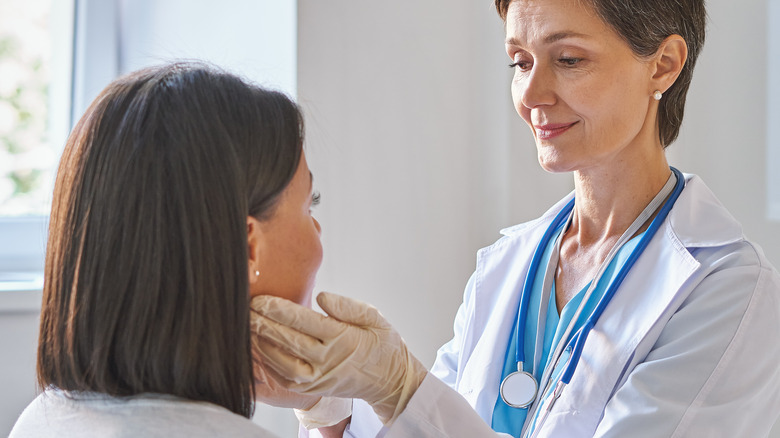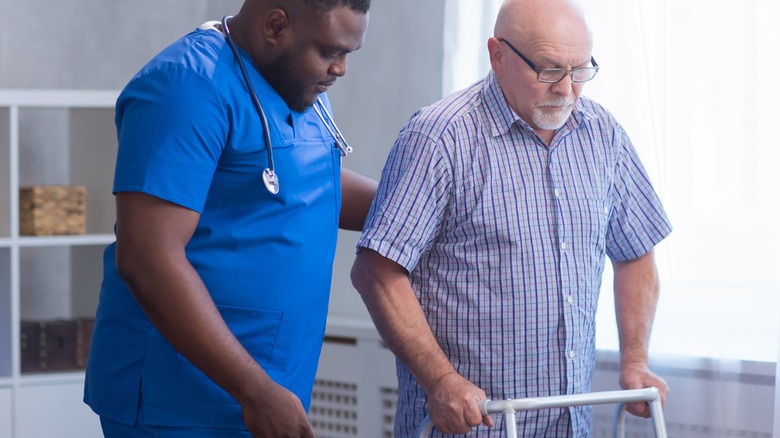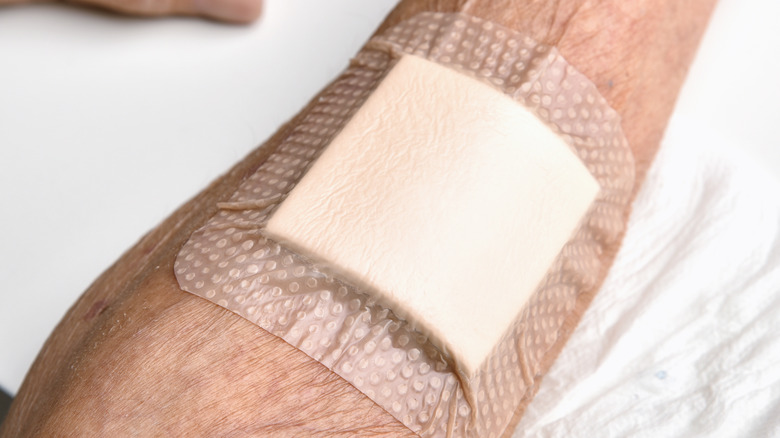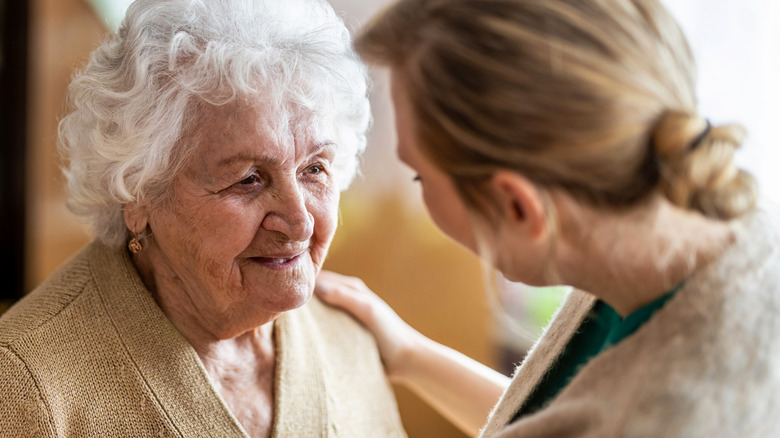Types Of Home Health Care Explained
Home health care is just what it sounds like: professional health care provided at a place of residence. Per the Centers for Medicare and Medicaid Services (CMS), it is "given by a variety of skilled health care professionals at home." They list many types of home health care services. They also claim that the need for home health care services has risen, and medical technology has gotten better, allowing expensive hospital services to be performed at home for a more affordable cost.
In fact, a report from technology company WellSky says home health care service usage levels in 2022 were 23% higher than they were in 2019, thanks in part to the COVID-19 pandemic. As a study from the Journal of the American Geriatric Society explains, increasing access to home health care services is especially important for older, homebound adults during a pandemic, as traveling to a hospital would put this population at greater risk of infection. With this in mind, home health care services can be a much better option than traveling to a health clinic or hospital for certain individuals.
Read on to learn about getting access to home health care, what types of home health care are available, and some of the health care services that can be provided at home.
Home health care is available through Medicare and Medicaid
The official U.S. Medicare website says that in order to receive medical care at home through Medicare, your doctor needs to certify that you need home health care and explain the type of services and how often they're needed in a detailed plan of care. The doctor also needs to certify that you are homebound (i.e., unable to leave your house to go to a health clinic), per Medicare Interactive.
Home health care is also available through Medicaid. The American Council on Aging says those with Medicaid are eligible for home health care, and that it is actually more cost effective for Medicaid to pay for home health care than for a stay at a nursing home. Those who receive home health care through Medicaid have the option of choosing their caregivers, such as close friends or relatives, who will then be paid by Medicaid for their work. In fact, if you are already acting as an unpaid caregiver for a friend or loved one, you may be eligible to be paid by Medicaid.
Additionally, home health care services can be paid out of pocket, though costs vary widely based on the type of service as well as the frequency and length of visits. Telehealth is another option for avoiding health center visits, and its usage has been especially beneficial during the COVID-19 pandemic, according to a 2020 systematic review from BMC Public Health.
Home health care can lower health care costs and improve outcomes for some patients
Home health care services are often preferable for certain populations who are homebound or at an increased risk of infection, but they provide another major benefit: They are usually less expensive than health care services provided by a hospital or traditional healthcare setting. The American Council on Aging says home health care services are generally more cost effective than the cost of similar services at a health clinic.
A study from Health Affairs tested the effects of applying a variation of Johns Hopkins University's Hospital at Home model to a healthcare system in Albuquerque, New Mexico, providing "hospital-level care" at patients' places of residence. This study found the costs for patients using home health care were 19% lower than those of inpatients requiring similar services. What's more, patients using home health care had similar or better outcomes than inpatients, and they also reported higher satisfaction levels. So, not only can home health care save you money, but it may be more effective and tolerable than care at a clinic.
A 2021 systematic review from the Journal of the American Medical Association that analyzed nine randomized clinical trials shows similar results: patients receiving home health care were at a lower risk for readmission than inpatients and also reported less depression and anxiety.
Nursing care
According to Johns Hopkins Medicine, the most common type of home health care is nursing care. This includes any type of service that can be provided by a nurse: blood tests, IV therapy, wound care, administering medication, checking in on the patient, and more.
Many studies have confirmed the effectiveness of home health care administered by nurses. A review from the Ontario Health Technology Assessment Series that analyzed 12 randomized controlled trials compared mortality, hospitalization, and health-related quality of life for patients with various types of heart disease who either received home health care or didn't receive any home health care. This review found patients who received at least one home health care visit from a nurse had improved outcomes compared to patients who didn't. Patients who received nursing care had fewer unplanned hospitalizations, lower all-cause mortality, and improved quality of life.
Similarly, another systematic review and meta-analysis from the European Journal of Heart Failure that looked at 53 randomized controlled trials found home nurse visits lowered mortality rates for patients who had recently been hospitalized for heart failure. Additionally, home nurse visits were found to lower hospital readmission rates, and they were also the most cost-effective intervention compared to nurse case management and disease management clinics.
Doctor care
In some cases, a home visit from a doctor may be necessary in order to diagnose an illness, or to help treat it. Johns Hopkins Medicine explains that a doctor may also occasionally review a patient's home health care needs. This makes sense, as the U.S. Medicare website says that a doctor must create a detailed plan of care in order for a patient to qualify for home health care (among other requirements).
A 2021 study from the Journal of the American Medical Association found the percentage of older adults who are homebound more than tripled between 2011 and 2020, from about 5% in 2011-2019 to 13% in 2020. This substantial increase in homebound older adults creates a greater need for home visits from physicians, as this population has increased difficulty attending doctor appointments outside the home. As an article from the Association of American Medical Colleges says, "Homebound patients often delay going to a doctor's office until their conditions have worsened."
Thankfully, primary care can be administered by physicians at home. Medicare's Independence at Home project has shown that home-based primary care can significantly lower healthcare costs among the population of homebound older adults.
Physical, occupational, and/or speech therapy
Johns Hopkins Medicine says that physical therapy, occupational therapy, and speech therapy can also be administered at home when necessary, and research shows that this can be effective. A randomized controlled trial from the Journal of the American Geriatric Society found home-based physical and occupational therapy for older adults with functional difficulties could reduce mortality risk. The mortality rate was 1% for the group who was receiving physical and occupational therapy at home, while the control group had a mortality rate of 10%.
Another randomized controlled trial from the Physical Therapy and Rehabilitation Journal compared the effects of home physical therapy vs. clinic-based physical therapy in patients with sprained ankles. This study found both the home and clinic-based intervention to be effective, but importantly, the group receiving physical therapy at home had significantly higher attendance and completion rates. This makes sense, as it's much easier to attend an appointment happening in your home than one in a clinic.
Medical social services
According to Johns Hopkins Medicine, medical social services are another type of health care that can be provided at home. Medical social services may include counseling the patient, helping the patient find relevant community resources, or even acting as the patient's case manager if the patient has a complex medical condition and requires many different services to be coordinated.
A study from Social Work in Health Care argues that social work is an essential component of effective home health care. Another study from Qualitative Social Work points out that "the home is the most common place where social work goes on," despite the fact that little research currently exists on the effectiveness of home-based social work. Per the study, social work at home is not merely an extension of clinical social work, but rather a separate, unique practice. For instance, they explain that it is common for home social workers to take inventory of the whole house, and social workers who work with children may do so in the child's bedroom, where certain patterns and habits can be observed that may otherwise not be visible to clinical social workers.
Home health aides
Home health aides can also be a part of home health care (via Johns Hopkins Medicine). Home health aides help patients with everyday tasks, including getting out of bed, getting dressed, walking, and bathing. Specialized training is sometimes necessary to assist with certain types of care, and some home health aides receive this training and work directly with a nurse to ensure the patient receives the specific care they need.
The American Association of Retired Persons (AARP) says that, as of 2021, adults aged 65 and older have about a 70% chance of needing some type of support from home health aides, and about 20% will need this type of care for five or more years. Thankfully, the number of home health aides is on the rise. AARP says that the Bureau of Labor Statistics predicts the number of home health aides to grow by about 33% by 2030, which is significantly greater than the average growth prediction for all occupations.
End-of-life care
The National Institute of Aging describes end-of-life care as "the support and medical care given during the time surrounding death." This includes far more than the moment of death, and may span days, weeks, or months depending on the patient's condition. For instance, those who live with multiple chronic illnesses may need significantly more care towards the end of their lives.
A 2016 review from the Cochrane Database of Systematic Reviews claims survey data shows that most older adults would prefer to receive end-of-life care at home, and not in a hospital. Additionally, home-based end-of-life care increases the likelihood of dying at home instead of at a hospital (as per some patients' wishes), and may reduce healthcare costs and increase patient satisfaction after one month (though the researchers claim the evidence for this was low-quality).
Another systematic review and meta-analysis from the Journal of Palliative Medicine that analyzed 15 studies shows that home-based palliative care can improve outcomes for patients, including satisfaction and quality of life.
Wound care
There are many different health care services that can be provided at home. For instance, the U.S. Medicare website says wound care is a common service provided at home for a variety of wounds, such as a surgical wound or a pressure sore.
Wound care is especially important for older adults. According to the Princeton Health Care Center (PHCC), the skin's ability to heal itself and the immune system response to prevent infection both slow down with age. For older adults who are homebound, home-based wound care is crucial to help wounds heal.
While home wound care may be administered by a nurse or specially trained home health aide, another option for home wound care is telemedicine. A review from Advances in Skin and Wound Care calls wound healing and wound management "prime candidates" for telemedicine, as caring for a wound may require frequent observations and assessments from health care professionals. This is something that can be done remotely, either by sending digital images of the wound or scheduling a video call.
Another study from the International Wound Journal says an important part of telemedicine wound care includes patient education, with detailed instructions on how patients can clean and dress the wound themselves.
Patient and caregiver education
Another important service that can be provided with home health care is patient and caregiver education (via the U.S. Medicare website). Any healthcare provider who administers health care at home should make sure to teach patients as much as possible about how to take care of themselves. They may also teach other caregivers or anyone else living with the patient about how to care for the patient.
Like wound care, patient education is another good contender for telemedicine. A systematic review from Patient Education and Counseling that analyzed 16 studies found patient education conducted via telehealth at least as effective, and in some cases even more effective, as patient education that was clinic-based. This review looked at studies of patients receiving education for one of several chronic illnesses, including diabetes, heart failure, irritable bowel syndrome, and chronic obstructive pulmonary disease, suggesting patient education provided via telehealth can have a wide variety of applications.
Intravenous or nutrition therapy
A review from the Emergency Medicine Journal says intravenous (IV) therapy, also known as fluid therapy or infusion therapy, is one of the most common procedures administered by emergency departments. Thankfully, this service can also be provided at home, and in most cases, doing so is much more cost effective. A 1995 study from the Medical Journal of Australia found home IV therapy to be more cost effective than IV therapy provided by a hospital, saving both money and hospital beds.
A more recent 2017 review from Healthcare Amsterdam that analyzed 13 studies found home IV therapy to be more cost-effective and tolerable than IV therapy provided by a clinic, claiming patients "overwhelmingly preferred" home care for IV therapy and had improved quality of life when treated at home. More specifically, patients reported fewer disruptions to their personal lives as well as improved mental and physical well-being when receiving IV therapy at home, highlighting some of the main advantages of home health care that extend beyond IV therapy.
Injections
Injections are another healthcare service that can be provided at home (via the U.S. Medicare website). Injections include different types of medications or nutrients that are administered with a syringe directly to your body's tissues, according to the National Cancer Institute.
Administering injections at home became especially important during the COVID-19 pandemic, according to the National Council on Aging (NCOA). The NCOA says older adults who are homebound can receive COVID-19 vaccination shots at home, and that Medicare will pay for the procedure.
Other types of injections are available to be provided at home, too. In fact, in some cases, home injections need not be administered by a trained healthcare provider. A study from the European Association for Palliative Care that evaluated a protocol teaching caregivers with no formal training, or "laycarers," to administer subcutaneous injections found the protocol effective and useful, suggesting injection therapy has the potential to be provided by a family member or loved one instead of a healthcare provider.
Monitoring serious illness
Another common home health care service involves tracking and monitoring patient outcomes during a serious illness. For instance, a systematic review from the Cochrane Database of Systematic Reviews says home palliative care can be particularly effective for cancer patients and can reduce symptoms. This review also looked at home health care to treat other diseases, including heart failure, multiple sclerosis, chronic obstructive pulmonary disease, and HIV/AIDS, finding home health care an effective option for all these conditions.
Home health care can also be effective for treating diabetes. A study from Health Education Research piloted a home-based care program for patients with diabetes. The home-based intervention involved eight weekly home sessions with a registered nurse focused on educating patients and modifying their behavior. These patients also received support via phone calls. This study found patients who received the home-based intervention had significantly improved symptoms, including blood pressure and glycemic control. Additionally, patients receiving diabetes care at home increased their knowledge, self-efficacy, and quality of life.
How to tell when it's the right time for home health care
Home health care has the potential to reduce healthcare spending (via a systematic review and meta-analysis from the European Journal of Heart Failure), but how do you know when it's necessary?
If you want to receive home health care through Medicare, a doctor needs to certify that you are homebound, according to Medicare Interactive. In order to be considered homebound, you must be unable to leave your home without help from medical equipment or another person and only leave your home on rare occasions. Alternatively, if your doctor thinks it's likely that your medical conditions could worsen if you leave your house, and you rarely leave your house, you are also considered homebound. Talk to your doctor or healthcare provider if you meet these conditions and would like to qualify for home health care.
That said, even if you aren't considered homebound or don't use Medicare, you still have the option of receiving home health care. Home health care can take many different forms, including telehealth or services that can be paid for out-of-pocket. Forbes Magazine provides a helpful list of criteria that may help you determine when the time is right for home health care. Essentially, those who are unable to take care of themselves — e.g., unable to do their own laundry, store food safely, clean up after meals, etc. — may be ready for home health care.















